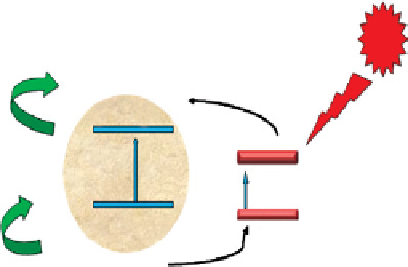Environmental Engineering Reference
In-Depth Information
Products
e
-
e
-
e
-
e
-
e
-
Dye
Cu
2
O
π*
OH•
PANI
h
+
h
+
h
+
h
+
π
h
H
2
O
figure 3.14
Scheme of the separation and transfer of photogenerated charge carriers in the Cu
2
O/PANI system under visible light
irradiation. Reproduced by permission from Ref. [155]. © 2012, elsevier B.V.
ion O
2−
and a hydroxyl radical ∙OH, which are responsible for the degradation of the organic compound. The possible
photocatalytic reactions are proposed as follows (eqs. 3.8-3.12):
+
−
Cu OPANI h uO PANI
/
+→ +
υ
/
e
(3.8)
2
2
−
−
+→
2
2
eO O
(3.9)
2
22
−
− + −
++→+
Oe H HOH
(3.10)
(3.11)
+
+ − +
+ ↔+ →+
hHOHOH H H
(
)
•
2
DyeOH
+ →
oxidationproducts
.
(3.12)
•
3.3.2 Cu
2
O-Based Nanocomposites for water disinfection
Water disinfection means the removal, deactivation, or killing of pathogenic microorganisms including a variety of helminthes,
protozoa, fungi, bacteria, rickettsiae, viruses, and prions. The conventional method for water disinfection is commonly accom-
plished by the addition of a strong oxidant such as free chlorine. However, the treatment process results in the formation of toxic
disinfection by-products (dBPs) such as trihalomethanes and haloacetic acids. Moreover, free chlorine is ineffective in controlling
some pathogens like
Cryptosporidium parvum
and
Mycobacterium avium
. UV/chlorine and ozone/chlorine combinations are
effective in killing the
C. parvum
oocyst. However, viruses are resistant to both UV and combined chlorine disinfection.
Additionally, ozonation and chlorination of water containing bromide can form other unregulated dBPs like haloacetonitriles
and iodoacetic acid, which are more toxic and carcinogenic than those associated with free chlorine. Thus, disinfection regula-
tions now require minimization of such by-products, and there is a strong demand for alternative technologies [173].
A promising disinfection method is to enhance the utilization of photons by integrating engineered photocatalytic
nanostructures in the treatment system. In 1985, Matsunaga et al. [2] reported the microbicidal effects of TiO
2
. Their
excellent research work gave rise to extensive research in the field of oxidative photocatalysis, mainly dealing with TiO
2
suspensions and targeting bacteria, viruses, fungi, algae, and protozoa. However, this approach has its own limitations:
(i) The efficiency of photocatalytic materials is limited by the recombination of photogenerated charges, and the bacteria
need to contact with the catalyst; (ii) the adsorption-desorption problems in the reaction systems have not been fully
addressed; (iii) it is still quite challenging to fabricate stable photocatalytic materials with high efficiency in the VL
spectral range. The discovery of new photocatalytic materials will be a major driving force for future developments in
the field of photocatalyzed disinfection. Novel photocatalysts such as titanium-free materials, coupled binary nanostruc-
tures, and even complex ternary composites are of great interest. Copper has a long history as an antimicrobial agent,
with its earliest recorded use in 2600 BC [174]. This metal in the form of copper ions [175], metals and alloys [176-
178], and oxides (Cu
2
O, CuO) [179] has been shown to exhibit excellent antimicrobial activity against a number of
microorganisms including bacteria and viruses, yet it is relatively safe for humans [180]. Cu
2
O is commercially used in
paints in the health care sector and as antifouling surfaces on a ship hull [181]. Crystallography facet-dependent anti-
bacterial activities of Cu
2
O were reported by Ren's [131] and Pang' groups [130]. Ren et al. [131] synthesized Cu
2
O
cubic and octahedral crystal samples and evaluated their bactericidal activity by the inactivation of
E. coli
. Owing to the

